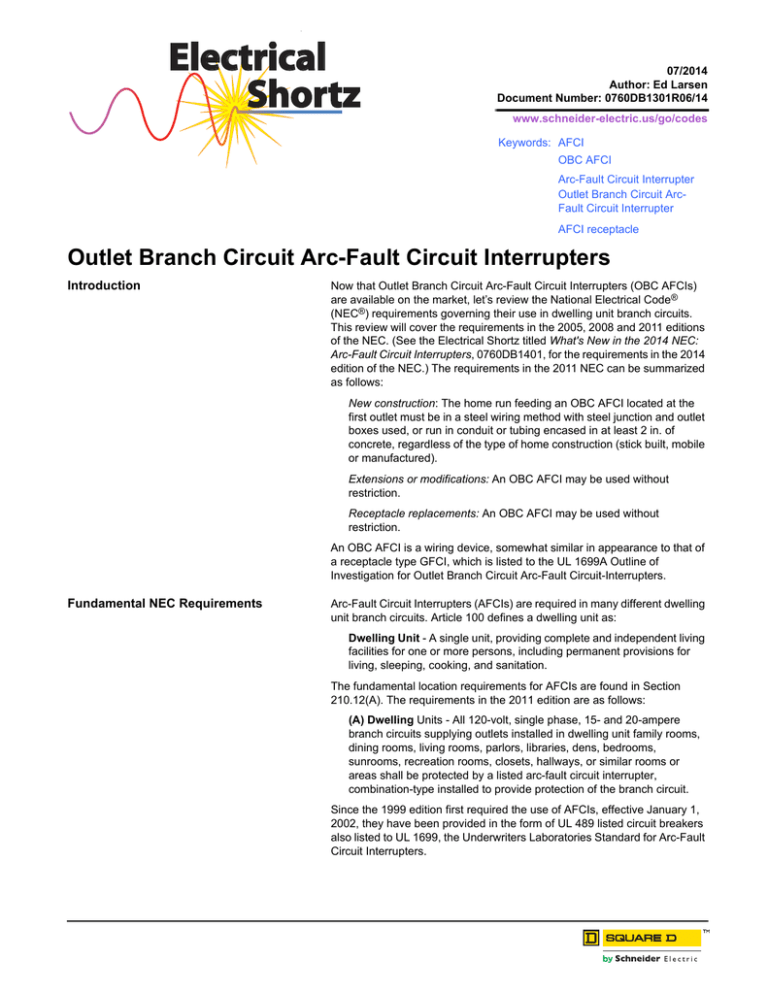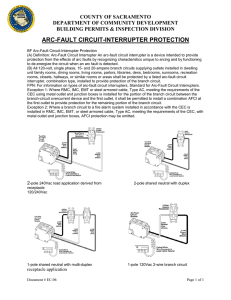
Electrical
Shortz
07/2014
Author: Ed Larsen
Document Number: 0760DB1301R06/14
www.schneider-electric.us/go/codes
Keywords: AFCI
OBC AFCI
Arc-Fault Circuit Interrupter
Outlet Branch Circuit ArcFault Circuit Interrupter
AFCI receptacle
Outlet Branch Circuit Arc-Fault Circuit Interrupters
Introduction
Now that Outlet Branch Circuit Arc-Fault Circuit Interrupters (OBC AFCIs)
are available on the market, let’s review the National Electrical Code®
(NEC®) requirements governing their use in dwelling unit branch circuits.
This review will cover the requirements in the 2005, 2008 and 2011 editions
of the NEC. (See the Electrical Shortz titled What's New in the 2014 NEC:
Arc-Fault Circuit Interrupters, 0760DB1401, for the requirements in the 2014
edition of the NEC.) The requirements in the 2011 NEC can be summarized
as follows:
New construction: The home run feeding an OBC AFCI located at the
first outlet must be in a steel wiring method with steel junction and outlet
boxes used, or run in conduit or tubing encased in at least 2 in. of
concrete, regardless of the type of home construction (stick built, mobile
or manufactured).
Extensions or modifications: An OBC AFCI may be used without
restriction.
Receptacle replacements: An OBC AFCI may be used without
restriction.
An OBC AFCI is a wiring device, somewhat similar in appearance to that of
a receptacle type GFCI, which is listed to the UL 1699A Outline of
Investigation for Outlet Branch Circuit Arc-Fault Circuit-Interrupters.
Fundamental NEC Requirements
Arc-Fault Circuit Interrupters (AFCIs) are required in many different dwelling
unit branch circuits. Article 100 defines a dwelling unit as:
Dwelling Unit - A single unit, providing complete and independent living
facilities for one or more persons, including permanent provisions for
living, sleeping, cooking, and sanitation.
The fundamental location requirements for AFCIs are found in Section
210.12(A). The requirements in the 2011 edition are as follows:
(A) Dwelling Units - All 120-volt, single phase, 15- and 20-ampere
branch circuits supplying outlets installed in dwelling unit family rooms,
dining rooms, living rooms, parlors, libraries, dens, bedrooms,
sunrooms, recreation rooms, closets, hallways, or similar rooms or
areas shall be protected by a listed arc-fault circuit interrupter,
combination-type installed to provide protection of the branch circuit.
Since the 1999 edition first required the use of AFCIs, effective January 1,
2002, they have been provided in the form of UL 489 listed circuit breakers
also listed to UL 1699, the Underwriters Laboratories Standard for Arc-Fault
Circuit Interrupters.
Outlet Branch Circuit Arc-Fault Circuit Interrupters
Electrical Shortz
NEC OBC AFCI Requirements
0760DB1301R06/14
07/2014
The requirements in the 2005 edition were stated in the form of an exception
to Section 210.12(B):
Exception: The location of the arc-fault circuit interrupter shall be permitted
to be at other than the origination of the branch circuit in compliance with (a)
and (b):
a. The arc-fault circuit interrupter installed within 6 ft. (1.8 m) of the
branch circuit overcurrent device as measured along the branch
circuit conductors.
b. The circuit conductors between the branch circuit overcurrent device
and the arc-fault circuit interrupter shall be installed in a metal
raceway or a cable with a metallic sheath.
The exception to Section 210.12(B) in the 2008 edition was rewritten and
expanded to provide more flexibility for installers:
Exception No. 1: Where RMC, IMC, EMT or steel armored cable, Type
AC, meeting the requirements of 250.118 using metal outlet and junction
boxes is installed for the portion of the branch circuit between the
branch-circuit overcurrent device and the first outlet, it shall be permitted
to install a combination AFCI at the first outlet to provide protection for
the remaining portion of the branch circuit.
The exception, now to Section 210.12(A), was rewritten and expanded once
again in the 2011 edition:
Exception No. 1: If RMC, IMC, EMT, Type MC, or steel armored Type
AC cables meeting the requirements of 250.118 and metal outlet and
junction boxes are installed for the portion of the branch circuit between
the branch-circuit overcurrent device and the first outlet, it shall be
permitted to install an outlet branch-circuit type AFCI at the first outlet to
provide protection for the remaining portion of the branch circuit.
Exception No. 2: Where a listed metal or nonmetallic conduit or tubing is
encased in not less than 2 in. (50 mm) of concrete for the portion of the
branch circuit between the branch-circuit overcurrent device and the first
outlet, it shall be permitted to install an outlet branch-circuit type AFCI at
the first outlet to provide protection for the remaining portion of the
branch circuit.
The code panel recognizes that placing the home run in steel conduit serves
three key functions:
1. The conduit protects the wire from physical damage such as a nail or
screw damaging the insulation of the conductors.
2. Any arcing fault due to a damaged conductor is contained with the
raceway, not exposing it as an ignition source
3. The metal raceway serves as a ground path to facilitate opening the
circuit breaker faster, protecting against any further fault hazard.
Use of OBC AFCIs in New Construction
2
2011 NEC 210.12(A) Exception No. 1 permits the use of an OBC AFCI in
the branch circuits serving the specified areas if the wiring between the
overcurrent device (circuit breaker) and the first outlet is RMC, IMC, EMT,
Type MC, or steel armored Type AC cable meeting the requirements of
Section 250.118. This portion of a branch circuit is typically referred to as
the “home run”. It also requires that metal outlet and junction boxes be
installed in the home run. Type NM cable and plastic outlet and junction
boxes may be used downstream from the OBC AFCI.
© 2013–2014 Schneider Electric All Rights Reserved
0760DB1301R06/14
07/2014
Outlet Branch Circuit Arc-Fault Circuit Interrupters
Electrical Shortz
Section 210.12(A) Exception No. 2 permits the use of an OBC AFCI if the
home run is installed in listed metal or nonmetallic conduit or tubing if the
conduit or tubing is encased in not less than 2 inches of concrete.
In order to fully understand these new exceptions, we need to understand
how the NEC defines an outlet. According to Article 100 an outlet is defined
as: “A point on the wiring system at which current is taken to supply
utilization equipment”. In other words, an outlet may be a receptacle, or it
may also be a luminary (lighting fixture) or some other type of utilization
equipment. This means that the home run must terminate in an OBC AFCI
before it feeds any type of utilization equipment.
Use of AFCIs in Branch Circuit
Extensions or Modifications
A new requirement regarding the extension or modification of branch
circuits serving specific areas was added to Section 210.12 in the 2011
edition:
(B) Branch Circuit Extensions or Modifications — Dwelling Units. In
any of the areas specified in 210.12(A), where branch-circuit wiring is
modified, replaced, or extended, the branch circuit shall be protected by
one of the following:
1. A listed combination-type AFCI located at the origin of the branch
circuit
2. A listed outlet branch-circuit type AFCI located at the first receptacle
outlet of the existing branch circuit
Note that steel or concrete encased wiring methods are not required for the
use of OBC AFCIs in extensions or modifications.
The code panel recognizes that in the case of a branch circuit extension, it
could be an extra hardship to require the protection of the entire already
installed branch circuit; therefore, protecting the addition of the branch
circuit was the focus.
Receptacle Replacements
A new requirement was also added in the 2011 edition regarding the
replacement of receptacles, effective January 1, 2014.
406.4 General Installation Requirements
(D) Replacements.
(4) Arc-Fault Circuit-Interrupter Protection. Where a receptacle outlet
is supplied by a branch circuit that requires arc-fault circuit interrupter
protection as specified elsewhere in this Code, a replacement
receptacle at this outlet shall be one of the following:
1. A listed outlet branch circuit type arc-fault circuit interrupter
receptacle.
2. A receptacle protected by a listed outlet branch circuit type arc-fault
circuit interrupter type receptacle.
3. A receptacle protected by a listed combination type arc-fault circuit
interrupter type circuit breaker.
This requirement becomes effective January 1, 2014.
Mobile and Manufactured Homes
© 2013–2014 Schneider Electric All Rights Reserved
AFCI protection of bedroom branch circuits in mobile and manufactured
homes has been required by since the 2002 edition. Section 550.25 was
revised in the 2011 edition to require compliance with Section 210.12.
3
Outlet Branch Circuit Arc-Fault Circuit Interrupters
Electrical Shortz
0760DB1301R06/14
07/2014
550.25 Arc-Fault Circuit-Interrupter Protection
(A) Definition- Arc-fault circuit interrupters are defined in Article 100.
(B) Mobile homes and manufactured homes - All 120-volt branch
circuits that supply 15- and 20-ampere outlets installed in family rooms,
dining rooms, living rooms, parlors, libraries, dens, bedrooms,
sunrooms, recreation rooms, closets, hallways, or similar rooms or
areas of mobile homes and manufactured homes shall comply with
210.12.
Summary
The requirements for use of OBC AFCIs in the 2011 NEC can be
summarized as follows:
New construction: The home run feeding an OBC AFCI located at the
first outlet must be in a steel wiring method, with steel junction and outlet
boxes used, or run in conduit or tubing encased in at least 2 inches of
concrete, regardless of the type of home construction (stick built, mobile
or manufactured). See Figure 1.
Extensions or modifications: An OBC AFCI may be used without
restriction.
Receptacle replacements: An OBC AFCI may be used without
restriction.
See the Electrical Shortz titled What's New in the 2014 NEC: Arc-Fault
Circuit Interrupters, 0760DB1401, for the requirements in the 2014 edition of
the NEC.
Figure 1:
2011 NEC Requirements for Using an OBC AFCI in New Construction
Wiring method must be steel (conduit,
tubing, MC or AC cable).
Home run may be in steel or nonmetallic
conduit or tubing if encased in 2 in. of
concrete.
Box must be
steel.
OBC must be first
outlet.
Home run is not permitted to be NM
or nonmetallic tubing.
For More Information
NFPA 70 National Electrical Code; 2005, 2008 and 2011 editions.
What's New in the 2014 NEC: Arc-Fault Circuit Interrupters, 0760DB1401
Schneider Electric USA, Inc.
1415 S. Roselle Road
Palatine, IL 60067 USA
1-888-778-2733
www.schneider-electric.us
“Electrical Shortz” are produced by the Schneider Electric North America Codes and
Standards Group. These documents provide general guidance on a specific issue.
Circumstances regarding particular installation issues may need further consideration.
© 2013–2014 Schneider Electric All Rights Reserved
Schneider Electric and Square D are trademarks owned by Schneider Electric
Industries SAS or its affiliated companies. All other trademarks are the property of
their respective owners.


